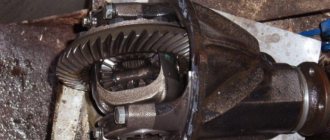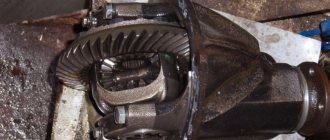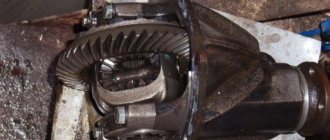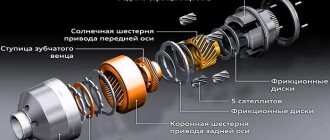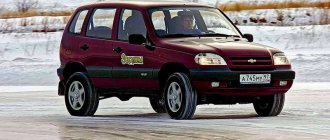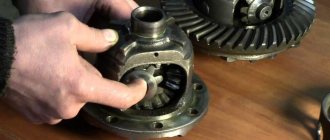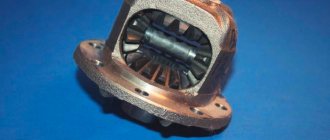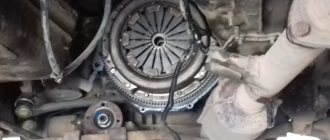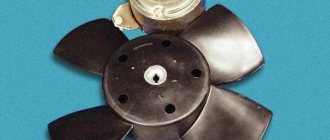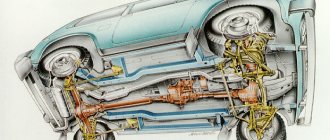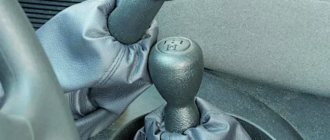Niva is a car that has been produced since 1977. It differs from other domestic cars in that it has permanent all-wheel drive. Few car enthusiasts know what this means, although they have heard a lot about this feature of the vehicle; a diagram of the device can easily be found on the Internet. All-wheel drive in the Niva is equipped for all 4 wheels, and the center differential is locked. The mechanism consists of a gearbox, a transfer case designed for 2 stages, and cardan shafts located in the front and rear of the machine. This also includes the front and rear axles.
When the engine starts to rotate, an impulse is sent to the gearbox and transfer case, after which the torque is distributed to the front and rear axles simultaneously. Afterwards, the gearboxes are activated, and behind them the front and rear wheels of the Niva begin to rotate. Torque causes 4 wheels to rotate at once, which is why it is called full torque. But the rear wheels still drive.
Why does Niva need blocking?
Wheel differential is a mechanism that allows a car to rotate its wheels at different speeds, which does not mean changing gears, but changing when cornering, when one wheel describes a small diameter and the other a large circle. In the absence of a differential, the wheels in the Niva would begin to slip, which could result in damage and rapid wear of the rubber.
When the vehicle moves on a flat road surface, the thrust from the engine is distributed evenly to the 4 wheels.
When at least one wheel slips, which often occurs on an icy road, the differential puts more force on the slipping wheel. In other passenger cars, such a device involves installation on a drive-type axle. Niva has it in other areas:
- on the rear and front axles;
- in the center between the axles, located near the gearbox and axles.
Functions of the differential device of the Niva Chevrolet
By automobile differential, experts mean a mechanical installation that includes a set of planetary gears and shafts. The functions of the Chevrolet Niva differential include the distribution of torque from the internal combustion engine of the vehicle to the drive wheels mounted on the same axle. Thanks to this, the car's wheels spin at different speeds.
The ability of the Chevrolet Niva wheels to spin at different speeds is very important when making turning movements. Especially when one wheel runs along a small radius, and the second wheel, located on the same axis, runs along a large radius. If there were no such device as an inter-wheel differential device, the vehicle's wheels would slip.
As a result of such spinning, the car would skid to the side, and the tires would wear out faster and lose their functional features.
When a Chevrolet Niva moves along a straight road at a constant speed, the inter-wheel differential device distributes the thrust from the internal combustion engine evenly between all wheels. This means that both driving wheels will rotate at the same speed. If any drive wheel slips, the differential will increase the traction force on the slipping wheel.
As a standard, a passenger car is equipped with one cross-axle differential on the drive axle. There are three such devices for the Chevrolet Niva; they are installed on:
- front axle;
- rear axle;
- at the center of the interaxial action.
A central differential device is needed to distribute the torque to both axles of the vehicle from the internal combustion engine.
How to enable differential lock on Niva
The Niva and its various modifications allow you to operate 3 differentials at once. Thanks to this factor, the vehicle’s cross-country ability increases significantly when driving in rural areas. The forced locking format involves connecting the driving wheels together, causing them to spin at different speeds. This approach allows you to use the maximum possible traction characteristics of the engine, which are transmitted to the wheels.
To lock the differential on the Niva, the manufacturer has provided a clutch for the locker. When forced locking is turned on, the wheels become interconnected and rotate in the same mode. When the inter-axle lock is activated, the axles located at the front and rear interact and distribute traction to all wheels. This mechanism is easy to use, which is confirmed by the unique cross-country ability of the Chevrolet Niva.
Advantages of forced blocking from IZH-TECHNO
What are the advantages of our forced blocking over existing analogues?
Forced locking kit
- The first, important point is the ease of installation and the availability of all the necessary components for installation . The differential assembly with our lock is installed in its standard place in the axle gearbox. You do not need to somehow “finish” the gearbox or purchase additional spare parts such as claw couplings or original axle shafts. Our locking is compatible with original axle shafts. All you need to install it is a standard set of plumbing tools. No “exercises” with a welding machine and grinder.
- Our locking system consists entirely of original components produced by IZH-TECHNO. Therefore, we guarantee the high quality of its individual components and locking elements; In turn, the high quality of components is a guarantee that you will not need any spare parts throughout the entire service life of the product, because there is simply nothing to break in it.
- We paid special attention to such a parameter as the strength of the satellite group . This is no coincidence: after all, it is she who transmits torque to both wheels of the axle and experiences the highest loads. The strength of the satellite group is confirmed by a series of tests carried out both in laboratory conditions and in real off-road conditions.
The lock has four satellites instead of the standard two
- The blocking has four satellites , instead of the standard two. This design allows for even distribution of torque and is more reliable than stock. We paid special attention to the parameters of the satellites themselves, increasing the thickness and height of the splines (see photo below):
On the left is a stock satellite, on the right is a satellite produced by IZH-TECHNO
- Protection of the pneumatic drive of forced blocking. The pneumatic drive is hidden inside the axle housing and is protected from mechanical influences; it cannot be broken or damaged.
- The differential housing is manufactured with high precision and strict tolerances , which ensures the absence of vibrations and noise in the axles when driving on the highway.
Niva differential housing cover
- Speed of blocking . By increasing the number of teeth involved in the differential locking, we achieved quick response of the locking mechanism. You don't have to wait for the wheel to rotate to 120 degrees for the system to finally work. In our case, 9 degrees will be enough.
- Versatility . The lock is suitable for all modifications and variants of Niva and Chevrolet Niva cars; it can be installed in both the rear and front axles, in both steel and aluminum front axle gearboxes. Locking options for 22 and 24 splines are available.
Read more about the features of forced blocking on Niva and Chevrolet Niva in the description on our website.
When to use and how to disable blocking
It is preferable to enable forced blocking in various modifications of the Niva in the following situations:
- The blocking must be turned on in advance if you have to overcome a difficult route.
- On sharp climbs uphill or when driving downhill.
- While crossing terrain with a top layer of sand.
- When you have to drive on snow drifts or an icy road.
Wheel locking is not necessary when driving quietly on a flat road within the city. Grip on asphalt surfaces will be decent, and traction will be distributed evenly by default.
Self-locking system
Can be configured to the required switching threshold. This can be either a slight slip or uneven distribution of torque among the wheels. Such a connection is not rigid, and therefore does not place unnecessary load on the interaxial connection.
When installing a forced locking system on a Chevrolet Niva, you should remember that a constantly turned on system can put unnecessary stress on the transmission, so you should turn it on only when overcoming difficult sections of the road.
Rules for applying blocking on Niva
To ensure that the locking mechanism lasts for a long time, use the following rules:
- It is necessary to switch the transfer case when the Niva does not move.
- The differential can also be engaged while the vehicle is moving.
- To ensure efficient and long-term operation of the device, it is advisable for the Niva driver to turn on the lock from time to time. Once a week in winter is enough.
Where is the lever responsible for switching located? Pay attention to the area between the wings located in front, there are 2 levers there. One makes it possible to change gears at the gearbox, the other successfully controls the transfer case.
The basis of the transfer case is a gearbox, which includes 2 stages. The control lever comes directly from it, you can move it forward and backward - this is how the gear is changed on the Niva. The direction of movement of the lever to the left and right allows you to activate the differential lock and vice versa to disable it.
Rules for using differential
These include:
- Switching the transfer case should only be done when the car is not moving.
- You can also engage the differential while the vehicle is moving.
- You can switch to a lower gear while the car is moving.
- To ensure long-term and uninterrupted operation of the differential, it is necessary to periodically turn it on, especially in winter. This should be done once every 7 days.
Shift lever location
In the interior of the Niva Chevrolet, there are two levers between the front seats . Using one of them you can change gears in the gearbox, and using the other you can control the transfer case.
Differential shift lever
The transfer case is based on a gearbox consisting of two stages . The control lever comes out of it into the cabin. He can move forward or backward. At the same time, it switches on/off downshift. If the lever is moved left or right, it can turn the differential lock on/off.
Gear shift and transfer case diagram
Downshift: what does it give?
The main component of the transfer case is the reduction gearbox . If the control lever is in the rear position, then the number of transfer cases decreases and is 1.2 . When the lever is in the forward position, the gear ratio increases. It will already be 2.1 . When the lever is in the neutral position, the gear ratio is 0 .
The differential is an integral part of the all-wheel drive mechanism in any car. It is recommended to use it only when the car is moving off-road.
Why is downshift needed?
It is difficult to imagine a transfer case without the main functional component - a reduction gearbox. Positioning the lever in the rear direction reduces the transfer case value to 1.2.
By fixing the lever at the front, the gear ratio can be increased to 2.1. The lever in neutral indicates gear ratio 0.
Characteristics and selection rules
The choice of a self-locking differential is determined by the car model, its operating conditions, driving style and many other parameters. For example, a ball differential increases steering load, which actually changes the driving style of whoever is behind the wheel. This is mainly felt when making U-turns and turns, but can lead to breakdowns of transmission components.
If you approach the choice of a self-block correctly, then you need to take into account which axle of the car the mechanism will be installed on, since the number of splines for different models is different - twenty-two or twenty-four.
The marking on the device packaging will tell you whether it can be used for a given car brand. The blocking coefficient also varies: for example, 0.5 or 0.7. These numbers show the amount of torque transmitted. What to choose is up to the driver.
Useful tips
To use the lock installed on the Niva effectively, use the following recommendations from experts:
- When driving on good quality road surfaces, install the front transfer handle at the front and the rear at the rear.
- The front handle is moved back if the road becomes slippery. Once the slippery area has been passed, switch the levers to normal mode.
- If the Niva is stopped, the lock may not engage when the clutch is depressed. This occurs due to the alignment of the teeth with the gear teeth. What should you do in this case? Moving as if on a turn, engage the lock. The differential will turn and the gear teeth will come closer to the teeth. If turning off is difficult, do it while the vehicle is moving, maintaining a minimum speed and squeezing the clutch.
How the cross-axle differential lock works on a Niva is clearly shown in the video:
How to turn on all-wheel drive
Since the drive on the Niva is constantly all-wheel drive, the question of how to turn on the all-wheel drive on the Niva Chevrolet means how to turn on the center differential lock.
You need to use blocking in the following cases:
- when driving in difficult terrain where there is a danger of wheel slipping;
- when there is a lack of engine thrust;
- when driving on a road covered with snow or ice.
Important: Blocking is useless when the car is hung diagonally, when one wheel on different axles begins to slip. This is due to the design feature of the transmission. In this case, you need to act according to the situation - dig up or pour under the hanging wheels.
The main component of the axle locking mechanism is the transfer case. The transfer case is controlled by one six-position lever. The longitudinal stroke provides higher and lower gear rows. Transverse - responsible for locking the center differential. When the lever is in lock mode, a yellow icon lights up on the instrument panel. There are no synchronizers in the design of the transfer case, therefore, when you try to engage the speed range or lock, the gears clash tooth to tooth. To switch, you just need to move the car forward or backward and then everything will switch.
Chevrolet Niva expedition › Logbook › * Self-locking differential in the bridge.
Friends, I want to share with you my short report on the operation of a self-locking differential. I would like to warn you right away that this is my personal opinion, which was formed after two years of using such devices.
We will talk about a screw differential lock. In pursuit of the cross-country ability of my former field, I began to build self-blocks into the bridges. After the sale of the Niva, the megadevices migrated to the Shevik, but were later dismantled. The devices are of course very interesting and really help to increase the vehicle's cross-country ability. The truth is not as much as you might expect. Let's just say that self-locking locks help you get stuck further than a standard differential. Sometimes automatic locking even gets in the way, especially on the front axle. This usually happens in slush or snow, when you need to turn onto a slope. The car stubbornly rows along the trajectory that it likes best, which does not always coincide with the driver’s opinion. Another disadvantage of self-blocks, even if only for the rear axle, is that in order for it to work as expected, frequent maintenance is required. In my experience of operating a Chevy in almost civilian mode, about once a quarter it is necessary to remove the lock to tighten the trigger moment. After half a year it doesn't hold up at all. This happens because the device is built on the basis of friction, and what rubs tends to wear off. If you do nothing after the preload weakens, then nothing bad and nothing good happens. The dissolved self-block begins to work like a regular differential, and simply becomes a “pill for the placebo effect.” It is also worth noting that with a fully working self-block, you need to very carefully gas on any heterogeneous surface, including snow and slurry. Especially on large wheels with pronounced tread. It is very easy to collapse the axle shaft in this situation.
How to do
The easiest way is to permanently lock the differential completely. But such a homemade blocking is acceptable for cars driving only off-road. For example, for rally-raid cars. To implement the idea, you need to remove the unit equipped with the differential and disassemble it. Then weld the satellites to the axles. Fixing the gears will allow the mechanism to divide the rotation speed between the axle shafts only in a ratio of 50 to 50. Making a limited slip differential with your own hands is a little more difficult than simply fixing the satellites. But such a modernization will not only improve the vehicle’s maneuverability in mud and snow, but will also not change the operation of the unit on hard surfaces. One version of such a device can be assembled from two brass or bronze bushings and a spring. Their sizes will depend on which vehicle transmission you are upgrading. Therefore, work begins with removing the assembly and disassembling the planetary gear. After this, you can take measurements, order the production of bushings and select a spring of suitable dimensions.
You will find out whether it is stiff enough after assembly by testing your homemade product. The spring is designed to press the pinion gears against the differential housing. Because of this, under the influence of friction, the satellites will rotate more slowly around their axis. The greater the friction force, the more evenly the speed of rotation of the driveshaft will be divided between the axle shafts. Metal bushings are needed to prevent contact of the satellites with the spring.
Of course, installing a factory-made differential lock is easier and the result of such an upgrade is better. However, it is expensive and practically eliminates creativity from the process. The cost of “self-blocks” for cars of the VAZ family is slightly less than 12 thousand rubles. But their installation requires only care and accuracy. There is no need for a special tool.
